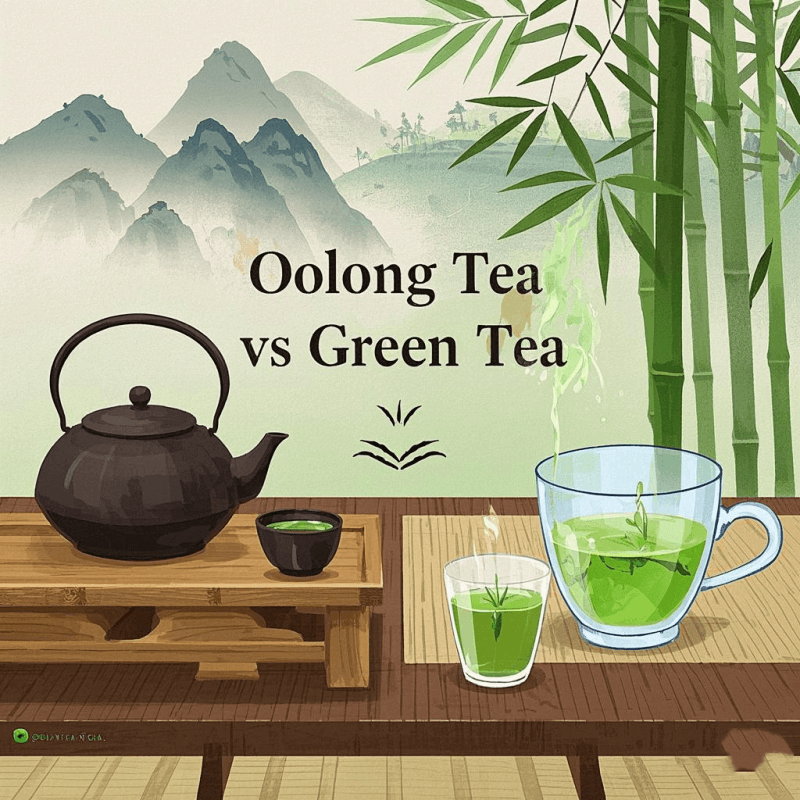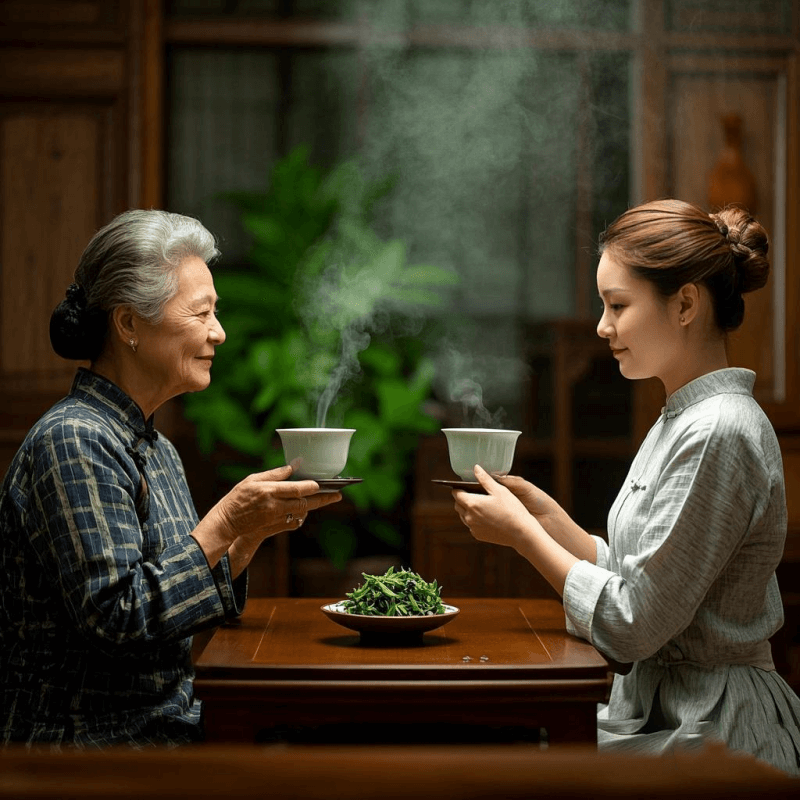
1. Introduction: Why Comparing Oolong Tea Versus Green Tea Matters
In a world where tea choices span continents and centuries, two beverages stand out for their complexity and health reputations: oolong tea and green tea. While both originate from Camellia sinensis leaves, their distinct processing methods create vastly different flavor profiles, nutritional compositions, and potential benefits. A 2023 survey by Tea & Coffee Trade Journal found that 65% of consumers struggle to choose between these two when seeking a flavorful yet functional brew—highlighting the need for a nuanced comparison.
Whether you’re a morning caffeine seeker, a wellness enthusiast, or a flavor connoisseur, understanding the differences between oolong tea versus green tea can transform your tea-drinking experience. From the oxidized depths of oolong to the fresh simplicity of green tea, let’s explore how these brews differ in taste, nutrition, and benefits to help you pick the perfect cup for every occasion.
2. What Is Oolong Tea? Origin, Process, and Flavor
Origins & Cultural Legacy
Oolong tea traces its roots to 16th-century China’s Fujian province, where it was first crafted in the Wuyi Mountains. The name “oolong” (literally “black dragon”) reflects both its twisted leaf appearance and the mythical stories surrounding its discovery. Today, it thrives in Taiwan, Vietnam, and even Hawaii, with each region adding unique twists to its production.
The Art of Semi-Oxidation
What sets oolong apart is its semi-oxidation process (8–85% oxidation), a middle ground between green tea’s minimal oxidation (0–10%) and black tea’s full oxidation (100%). The steps include:
- Withering: Leaves dry under the sun or indoors to reduce moisture.
- Oxidation: Gently bruised or shaken to expose enzymes to air, developing complex flavors.
- Firing/Baking: Heat halts oxidation, locking in notes that range from floral to roasted.
Flavor Spectrum
Oolong’s flavor defies easy categorization, spanning:
- Lightly oxidized varieties (e.g., Taiwanese High Mountain Oolong): Delicate floral notes (jasmine, orchid) with a crisp, honeyed finish.
- Highly oxidized varieties (e.g., Wuyi Rock Tea): Robust roasted flavors (toasted nuts, caramel) with a smoky, earthy backbone.
For those eager to explore this diversity, Discover the subtle beauty of oolong tea with our premium leaves, sourced from heritage farms that preserve traditional craftsmanship.
3. What Is Green Tea? History, Processing, and Characteristics
Ancient Roots & Global Reach
Green tea’s story begins in ancient China over 4,000 years ago, later spreading to Japan, Korea, and beyond. It’s revered in Japanese tea ceremonies and celebrated in Western wellness circles for its fresh, grassy appeal.
The Art of Preservation
Green tea’s defining feature is its minimal oxidation (0–10%), achieved by quickly halting enzyme activity through:
- Steaming (Japanese style, e.g., matcha, sencha): Preserves vibrant green color and umami richness.
- Pan-frying (Chinese style, e.g., Longjing, Biluochun): Enhances nutty aromas and a smoother mouthfeel.
Flavor Profile
Green tea’s flavor is characterized by:
- Freshness: Bright, vegetal notes (spinach, grass) in steamed varieties.
- Nutty sweetness: Roasted undertones in pan-fried versions, like Longjing’s chestnut aroma.
- Umami depth: Especially pronounced in high-quality matcha and gyokuro.
4. Oolong Tea Versus Green Tea: Nutritional and Caffeine Differences

Caffeine Content
- Oolong tea: 12–55mg per 8oz cup (moderate, depending on oxidation; higher in roasted varieties).
- Green tea: 20–45mg per 8oz cup (consistently moderate, lower in aged or decaffeinated versions).
Caffeine sensitivity tip: Oolong’s varied caffeine levels make it ideal for those who want to adjust their intake—opt for lightly oxidized oolongs for a gentle boost, or roasted styles for a bolder kick.
Antioxidant Profiles
Both teas are rich in polyphenols, but their profiles differ due to oxidation:
- Green tea: High in catechins (e.g., EGCG), known for their anti-inflammatory and antioxidant effects. A Healthline article notes EGCG levels are highest in unoxidized teas.
- Oolong tea: Contains theaflavins and thearubigins from partial oxidation, which may support heart health and metabolism more effectively than green tea’s catechins, according to a 2020 study in The Journal of Nutrition.
Calories & Nutrients
Both are virtually calorie-free (0–2 calories per cup, unsweetened), but oolong’s oxidation process may enhance bioavailability of certain compounds, like amino acids that aid relaxation.
5. Flavor Profiles: How Oolong and Green Teas Differ on the Palate
Oolong Tea: A Journey Through Layers
- Aroma: Ranges from ethereal floral (Taiwanese High Mountain) to deeply aromatic (Phoenix Dan Cong’s honey orchid notes).
- Taste: Balances sweetness, bitterness, and umami, with roasted varieties offering caramelized depth and lightly oxidized ones showcasing citrusy brightness.
- Mouthfeel: Often full-bodied and smooth, with a lingering aftertaste (“hui gan”) that invites multiple steeps.
Green Tea: Freshness in a Cup
- Aroma: Predominantly grassy, vegetal, or herbaceous, with subtle floral hints in premium grades.
- Taste: Bright and crisp, with a slight astringency that balances umami richness—think sencha’s seaweed notes or matcha’s creamy, bitter-sweet profile.
- Mouthfeel: Lighter and more refreshing, ideal for those who prefer clean, straightforward flavors.
Pairing Tips
- Oolong: Complements rich foods (roasted meats, aged cheeses) and desserts due to its boldness.
- Green tea: Enhances light dishes (sushi, salads) and is a classic match for umami-heavy meals.
6. Health Benefits Compared: Which Tea Offers What Advantages?
Oolong Tea’s Key Benefits
- Metabolism Support: Studies, including a 2017 trial in Obesity Research, linked oolong consumption to increased fat oxidation during exercise, making it a popular choice for fitness enthusiasts.
- Heart Health: Theaflavins may improve cholesterol levels and blood vessel function, according to the American Heart Association.
- Mental Alertness: Moderate caffeine combined with L-theanine (an amino acid) provides focused energy without jitters.
Green Tea’s Key Benefits
- Cancer Prevention: High EGCG levels are associated with reduced risk of certain cancers, per a National Cancer Institute review.
- Brain Health: L-theanine in green tea promotes alpha brain waves, enhancing relaxation without drowsiness—a boon for stress management.
- Diabetes Management: Regular consumption may improve insulin sensitivity, as noted in a 2021 meta-analysis in Nutrients.
Overlap & Differences
Both teas support immune function and hydration, but oolong’s oxidized compounds may offer stronger metabolic benefits, while green tea excels in unoxidized antioxidant potency.
7. Which One Should You Choose? Practical Tips for Tea Drinkers
1. Morning Rituals
- Go for oolong if you want sustained energy without coffee-like jitters (e.g., a moderately oxidized Phoenix Dan Cong).
- Choose green tea for a gentle morning refresh (e.g., pan-fried Longjing with breakfast).
2. Post-Meal Sipping
- Oolong aids digestion with its bold flavors and potential fat-busting properties—ideal after rich meals.
- Green tea offers a clean, palate-cleansing finish, especially with Asian cuisine.
3. Wellness Goals
- Weight management: Oolong’s metabolism boost makes it a strategic choice.
- Antioxidant focus: Green tea’s high catechins suit those prioritizing disease prevention.
4. Flavor Preferences
- Complexity seekers: Dive into oolong’s diverse profiles with our collection that spans floral to roasted.
- Freshness lovers: Stick to green tea’s crisp, clean taste, enhanced by authentic teaware designed for optimal steeping.
5. Caffeine Sensitivity
- Lightly oxidized oolongs or decaffeinated green teas are excellent low-caffeine options.
8. Conclusion: There’s No “Better”—Only “Better for You”
The choice between oolong tea versus green tea isn’t about superiority but suitability. Oolong shines as a versatile, flavor-rich companion for those who crave complexity and metabolic support, while green tea remains a timeless classic for its freshness and antioxidant prowess.
Ready to explore? Browse our oolong tea collection for every taste preference and discover how this semi-oxidized brew can elevate your routine. Whether you sip it gongfu-style to appreciate its layered flavors or enjoy a simple mug of green tea for its clarity, the perfect brew is out there—waiting for you to choose.
Remember: Tea is more than a beverage; it’s a ritual. By understanding these two iconic brews, you’re not just picking a tea—you’re curating an experience. So go ahead, steep, sip, and savor the journey.
Compare oolong tea versus green tea to find your perfect brew! Explore flavor, nutrition, and health benefits differences to make an informed choice for your lifestyle. 🍵
